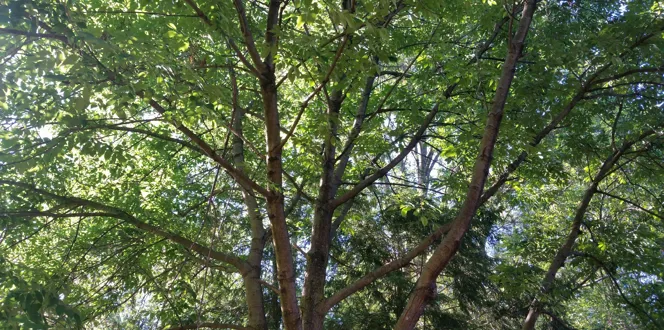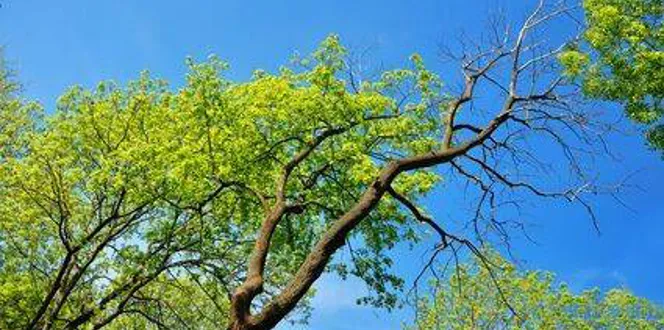Flashback to 2002. A tiny, exotic beetle, identified as emerald ash borer, was just discovered in Michigan.
By 2009, EAB killed an estimated 58 million ash trees in thirteen states, according to Dr. Leah Bauer of the USDA.
EAB was once thought to be a death sentence for your trees. Now, we know it’s not. You can treat EAB and save your ash trees.
Below, we’re answering your most common questions about EAB treatment:
What is the effectiveness of emerald ash borer treatment?
For emerald ash borer treatment to work, your tree first has to be inspected to check for other pre-existing conditions.
Once this examination is complete, your tree can be deemed a good candidate for preservation.
Then, the EAB treatment has to be applied at the right time, in the right way, by a certified applicator.
If all these steps are taken, the effectiveness of EAB treatment is 85 to 95 percent.
What are the EAB treatment options?
There are four types of EAB treatment options: soil injection, trunk injection, bark spray and canopy spray.
The most common EAB treatments are soil injections and trunk injections. Both deliver the product right into the tree's tissue, which is then evenly dispersed throughout the canopy. The injections target the larvae tunneling in the tree, which stops the most destructive phase of this insect.
Canopy sprays are also used occasionally, which help prevent adult borers from feeding and laying eggs. Systemic applications help limit environmental exposure.
Do DIY emerald ash borer options work?
For EAB treatments to be effective the product, dose, application timing, and overall health of the tree have to be considered.
Products available to homeowners have the same active ingredients that are available to professionals like Davey.
That being said, not all homeowner products contain a high enough concentration to be applied at the rates recommended by researchers.
For a problem like EAB that will kill your tree, applying the proper dosage is critical. That's why a professional tree inspection and treatment program are advisable.
What is the best time to treat for emerald ash borer?
Proactively! If EAB is in your area, don’t wait. You vastly improve the chances of your trees surviving and optimizing the effectiveness of the treatment when you act early.
Even if your ash tree still looks healthy, get it inspected if EAB is in your region.
EAB has been found in 25 states, including: Michigan, Ohio, Indiana, Illinois, Maryland, Pennsylvania, West Virginia, Wisconsin, Missouri, Virginia, Minnesota, New York, Kentucky, Iowa, Tennessee, Connecticut, Kansa, Massachusetts, New Hampshire, North Carolina, Georgia, Colorado, New Jersey, Arkansas and Louisiana. For an updated list, visit the USDA.
Also, be on the lookout for these early warning signs of EAB – or you can check out the corresponding infographic.
What is the cost of emerald ash borer treatment?
The cost of EAB treatment varies based on how many trees you have and the type of treatment needed. A certified arborist would be able to give you an exact number during a consultation.
Across the board, though, we know EAB treatment is significantly cheaper than removing a tree. Plus, when you treat your trees, you get to enjoy their beauty and benefits for the next decade.
Does emerald ash borer treatment work?
Yes! When applied correctly, EAB treatment is 85 to 95 percent effective.
EAB treatment works to save trees in your yards and your city.
For example, when EAB was detected in Naperville, IL, they treated their trees. Three years later, more than 90 percent of the treated ash trees show no signs of infestation.
Similarly, Joyce Kugeler of Lafayette, Colorado was worried about emerald ash borer attacking her ash trees. So, she called her local Davey Tree office in Boulder for help.
Together, they formed a plan. They treated and pruned the most valuable ash trees, removed unhealthy ash trees and planted new, diverse trees for the future.
Joyce can assure you - EAB treatment does work.
“Our yard looks better than ever, and all of our important ash trees are thriving. I’m so glad that Davey had years of experience with dealing with Emerald Ash Borer. It allowed us to come up with a great plan for our property. A plan based on experience and not guesses,” she shared.





